Press
Faces magazine
Faces magazine was published by Bob Guccione (Penthouse, Omni) as a general celebrity and culture magazine (not related to the later UK magazine The Face). Issue 2, dated 30th November 1975, profiled Space: 1999 on pages 20-25.
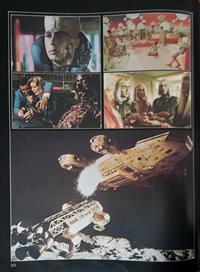
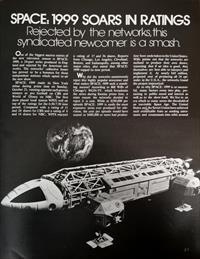
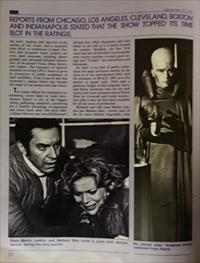
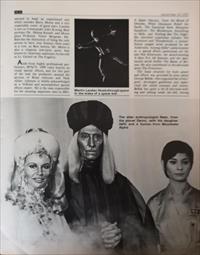
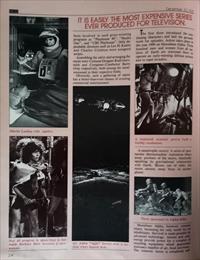
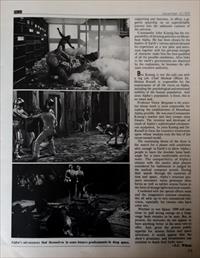
One of the biggest success stories of the new television season is SPACE: 1999, a 24-part series produced in England and rejected by the American networks. The networks' collective boner has proved to be a bonanza for those independent stations which opted to air the new show.
SPACE: 1999 made its New York debut during prime time on Sunday, October 21, running opposite such proven winners as pro football on CBS and World of Disney on NBC. The first show placed local station WPIX well on top of the ratings for the time period. Compared with a rating of 11 and 24 shares for CBS and a rating of 6 and 14 shares for NBC, WPIX enjoyed a rating of 17 and 36 shares. Reports from Chicago, Los Angeles, Cleveland, Boston, and Indianapolis, among other major cities, also stated that SPACE: 1999 topped its time period.
Why did the networks unanimously reject this highly popular newcomer and what makes SPACE: 1999 such a smashing success? According to Bill Wills of Chicago's WGN-TV, which broadcasts the series during Sunday prime time, a main reason the networks decided to reject it is cost. While at $250,000 per episode SPACE: 1999 is easily the most expensive series ever produced for television, the cost per episode would have soared to $400,000 or more had production been undertaken in the United States. Wills points out that the networks are inclined to produce their own shows, reasoning that if an idea is good, they themselves are best able to interpret and implement it. At nearly $10 million, projected cost of producing all 24 episodes in the U.S.A., the networks found the project impractical.
As to why SPACE: 1999 is so successful, many factors comp into play, pertaining to public mood and interest as well as to the show itself. We live in an era which to many seems the threshold of an inevitable Space Age. The United States and the Soviet Union have achieved such remarkable feats as sending astronauts and cosmonauts into orbit around the earth, landing craft and men on the surface of the moon, and a successful joint effort to rendezvous in space. Present and proposed future projects are even more awesome, including photographic and advanced technical exploration of the planets Venus, Mars, Saturn, and Jupiter. The frequency of reported incidents involving UFO's seems to grow in proportion to public acceptance of their credibility. Truly it can be said that yesterday's science fiction has become the shape of our present and near future.
The media reflects the times and to an increasing extent helps to mould them. Science fiction is one of the biggest-selling publishing categories, accounting for a healthy percentage of paperback and comic book sales. The movie 2001: A Space Odyssey was one of Hollywood's all-time box office champions and continues to do well as it is shown around the country. Similarly, the Star Trek series was one of television's most popular ever-reruns continue to enjoy good ratings and "Trekkie" fan conventions pull thousands.
So there, is no lack of public enthusiasm for space adventure whether in the news or in the entertainment field. And the producers of SPACE: 1999 serve this interest in grand style. With such a generous budget at their disposal, Gerry and Sylvia Anderson-who for the past twelve years have produced science fiction films for Universal and United Artists- were able to hire the best talent available for all key areas of production.
Husband and wife team Martin Landau and Barbara Bain, veteran stars of the hit series Mission Impossible, were selected to head an experienced cast which includes Barry Morse and a very respectable roster of guest stars. Landau is cast as Commander John Koenig, Bain portrays Dr. Helena Russell, and Morse plays Professor Victor Bergman. Ms. Bain has the distinction of being the only actress to have won Emmys three years in a row, as Best Actress. Mr. Morse is also a ringwise television actor, best known to American audiences for his role as Lt. Gerard on The Fugitive.
Aside from highly professional performers, SPACE: 1999 relies heavily on visual special effects, and for this part of the task the producers secured the services of Brian Johnson and Nick Allder. Johnson is widely acknowledged as a brilliant and accomplished special effects expert. He is the man responsible for the amazing sequences seen in 2001: A Space Odyssey, Taste the Blood of Dracula, When Dinosaurs Ruled the Earth, The Tamarind Seed, Mosquito Squadron, The Blockhouse, Something to Hide, and Nothing But The Night. His television experience includes The Protectors and Thunderbirds, a science-fiction puppet series produced by the Andersons. Among Allder's achievements as a special effects cameraman are the epic film Khartoum, the award-winning A Man For All Seasons, and the spectacular aerial thriller The Battle of Britain. He also contributed to the television series The Protectors.
The basic structure for both actors and effects was provided by story editor George Bellak, who organized the writers' pool, developed guidelines and supervised the initial concepts and stories. Bellak has quite a bit of television writing and editing under his belt, having been involved in such prize-winning programs as "Playhouse 90", "Studio One", and "CBS Playhouse". Only dependable directors such as Lee H. Katzin and Charles Crichton were assigned scripts.
Assembling the attire and arranging the music were Costume Designer Rudi Gernreich and Composer/Conductor Barry Gray respectively, both among the most-renowned in their respective fields.
Obviously, such a gathering of talent has a better-than-even chance of creating commercial entertainment.
The first introduced the continuing characters and laid the ground work for episodes. Action takes place in the year 1999 on Moonbase Alpha. Three hundred men and women from all nations of Earth are stationed there to operate an early warning defence system and to repel invaders.
A catastrophe occurs: A series of spectacular thermonuclear explosions blasts away portions of moon, drastically upsetting its gravitational relationship with Earth. Blown out of orbit, the moon careens away from its mother planet.
Moonbase Alpha, however, remains intact, becoming the only world for its inhabitants. Survival is made possible by advanced technology. Atomic and solar energy provide power for a complex of recycling equipment which guarantees necessary supplies or air, food and water. The runaway is completely self-supporting and becomes, in effect, a gigantic spaceship on an unpredictable journey into the unknown vastness of the universe.
Commander John Koenig has the responsibility of directing activities on Moonbase Alpha. He has been chosen by the leaders of Earth's various nations because his experience as a test pilot and astronaut together with his personal strength of character make him the best-qualified of all the possible candidates. After links to the earth's governments are shattered by the explosions, he becomes the ultimate executive authority.
But Koenig is not the only one with a big job. Chief Medical Officer Dr. Helena Russell is responsible for the maintenance of all life forms on Alpha, including the psychological and emotional stability of the human population. And since Alpha's population is fixed, this is no mean task.
Professor Victor Bergman is the scientist whose work is most responsible for making the establishment of Moonbase Alpha possible. He was once Commander Koenig's teacher and they remain close friends. The inventor and developer of much of Alpha's sophisticated computer-run equipment, he joins Koenig and Dr. Russell to form the executive triumvirate upon whose wisdom rests the fate of the moon-turned-world.
The continuing theme of show is the search for a planet with conditions akin enough to Earth's to allow Alpha's people to leave the desolate lunar scape for a more comfortable environment. The compatibility of Alpha's citizens with the sundry alien planets considered for habitation is judged by the computer system. During their through the mysteries of time and space, Alpha's reluctant pioneers encounter many grotesque alien forms as well as subtler cosmic forces in the form of strange lights and eerie sounds.
Combined with the special effects team and the imaginative costume creations, this all adds up to very commercial television, especially for viewers who have colour sets.
Whether or not Space: 1999 will continue to pull strong ratings on a long-range basis remains to be seen. But, at present, the networks do not appear to have anything better in the same vein to offer. And, given the proven public appetite for science fiction and space adventure, it would appear that the show's producers and broadcasters can continue to thank their lucky stars.
-J.C. Wilcox
Space 1999 copyright ITV